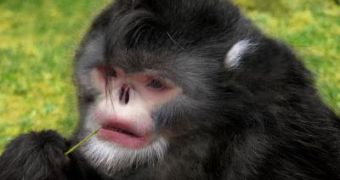A new species of monkey has been discovered by an international team of primatologists, in Northern Myanmar (formerly Burma).
The new species called Rhinopithecus strykeri, is a type of snub-nosed monkey, with prominent lips and wide upturned nostrils, which cause it to sneeze when it rains.
Thomas Geissmann, the leader of the taxonomic description, says that the monkey has almost entirely black fur, with white fur only on ear tufts, chin beard and perineal area.
The animal also has a really long tail, nearly 140% of its body size.
This new species was discovered during the nationwide Hoolock Gibbon Status Review in early 2010, by a team of field biologists led by Ngwe Lwin from the Myanmar Biodiversity And Nature Conservation Association and supported by an international team of primatologists from Fauna & Flora International (FFI) and the People Resources and Biodiversity Foundation.
The name of the species is in honor of Jon Stryker, President and Founder of the Arcus Foundation who supported the project, but in local dialects, the monkey is called “mey nwoah”, which means “monkey with an upturned face”.
For scientists this is a new species, but the locals say that it is very easy to find, as it sneezes when it rains because they often get rainwater in their upturned noses.
Also because of the shape of their nose, the monkeys keep their heads tucked between their knees during rainy days.
These monkey were reportedly spotted from the eastern Himalayas to the northeastern Kachin state, which led the team to carry out several field surveys in this area.
Frank Momberg, FFI's Regional Program Development Coordinator, for Asia Pacific, talked to the local hunters during these field surveys and concluded that this type of monkey is limited to the Maw River area.
The team found a small population of this new species, with characteristics unlike any other snub-nosed species previously known.
The 260 to 330 monkeys belonging to this species live in an area of nearly 270 square kilometers, which means that they are classified as Critically Endangered by IUCN.
The probable reason for which the Rhinopithecus strykeri has not been identified earlier is because it lives in an isolated area, between the Mekong and the Salween Rivers.
Local hunters say that during the hot summer months, from May to October, the monkey climb to higher altitudes, where the climate is more temperate, but during winter, they descend closer to the villages, looking for food.
There are other species of snub-nosed monkeys that live in parts of China and Vietnam, and all are considered endangered.
This is the first species that has been reported in Myanmar, and it is already highly endangered because of the logging roads built by Chinese companies, invading their territory.
“We are committed to taking immediate conservation action to safeguard the survival of this important new species together with our partners and local communities in Myanmar,” said Mark Rose, Chief Executive of Fauna & Flora International.
The research was published in the American Journal of Primatology.

 14 DAY TRIAL //
14 DAY TRIAL //